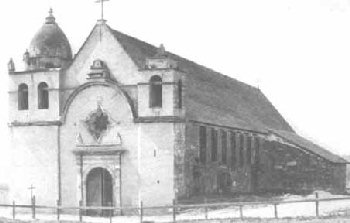 |
 |
|
San Carlos Borromeo de Carmelo
Two hundred years ago San Carlos Borromeo was the headquarters of the Franciscan chin of California missions. The renowned Father-Presidente Junipero Serra resided here (1770 - 1784) while supervising the first nine of these pioneer religious establishments and his tomb is today beneath the altar in its sanctuary. Serra’s statue in the Hall of Fame in Washington shows him holding in his hand a miniature of his favorite mission-San Carlos. First dedicated at Monterey on June 3, 1770, the mission was moved five miles south the following year to this verdant valley of the Carmel River and was henceforth known as Mission San Carlos Borromeo de Carmelo. Here the indians were no longer intimidated by the rough manners of the soldiers at the Monterey presidio. Camera buffs love this “Carmel Mission” not only for its gardens, fountain, doorways, belfry and crooked star-shaped window over the entrance, but also for its intriguingly romantic general appearance. There’s a unique Moorish influence in the solid sandstone church build by Manuel Ruiz, the professional stonemason imported from Mexico. He completed this edifice in 1797 for Father-Presidente Fermin Lasuen, “the builder” who developed the familiar tile-roofed mission style while founding nine more missions. The original Serra mission was a crude thatch-covered log shelter. The museum at San Carlos is a tourist delight that includes a replica of the old mission kitchen. The bare cell in which ascetic Father Serra slept on a cot of boards has been restored. Some of the tombstones at the mission are conversation pieces like that of “old Gabriel... aged 151 years” (who actually lived to be only 119). In the Serra chapel a traumatic sarcophagus by sculptor Jo Mora reminds you that two other great Franciscans, born like Serra on the Mediterranean island of Majorca-Father Francisco Palou, his biographer, and Father Juan Crespi, the faithful diarist served at San Carlos. Father Crespi is buried there. The grave of Father Lasuen is also under this mission, which remained the California headquarters until his death in 1803. After its “secularization” in 1834 removed the mission from Franciscan control, San Carlos quickly fell into decaying ruins for a half century. By 1851 the roof had caved in, filling the sanctuary with rubble. Tall weeds grew through the open doorways. When a campaign for repair and restoration started in 1882, a steep single roof was unfortunately built over the church and remained an architectural eyesore until replaced with the present tiles in 1934. Luckily, Harry Downie, California's master mission-restorer, took charge of research and reconstruction at San Carlos in 1930s. Under his direction, the church regained its original eighteenth century charm and the entire quadrangle was realistically rebuilt. Inside the church entrance you will see a plaque recognizing his importance. Stately Mission San Carlos Borromeo de Carmelo, classified as a basilica, is named in honor of a fearless Cardinal of the Counter-reformation Saint Charles Borromeo, who was canonized in 1584. In memory of the Carmelite friars who accompanied Sebastian Vizcaino on his 1602 exploration of Monterey Bay, the river near the mission is called Rio Carmelo. |